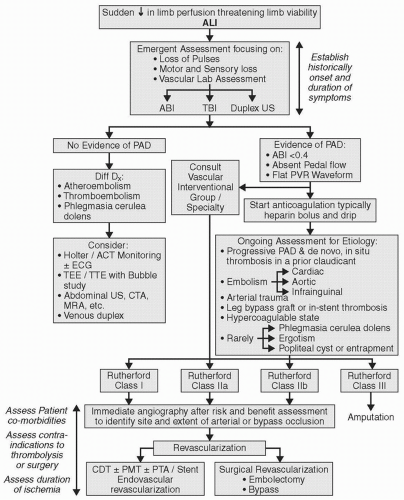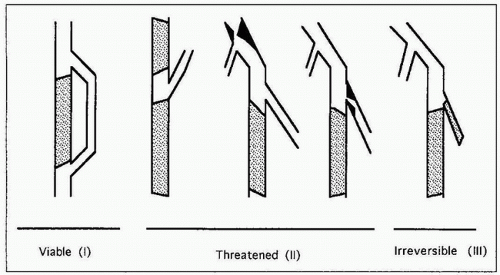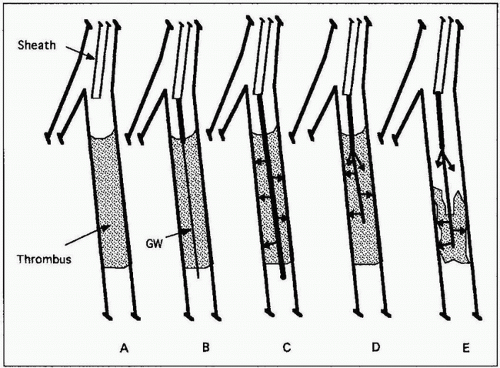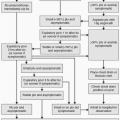 FIGURE 14.1 • Algorithm for the evaluation and management of acute limb ischemia (ALI). Once diagnosed, anticoagulation is initiated with subsequent treatment depending on classification of the ALI. Initial options include catheter-directed thrombolysis (CDT) with or without percutaneous mechanical thrombectomy (PMT) or surgical revascularization. Clinical categories of ALI include limbs that are (a) viable, with no immediate threat of tissue loss, intact muscle power and sensations, and audible arterial/venous Doppler signals; (b) marginally threatened, with a threat of tissue loss, minimal or no sensory loss, intact muscle power weak, and often inaudible arterial Doppler signals but intact venous Doppler signals (treated promptly, these limbs are salvageable; these limbs afford time for vascular imaging); (c) immediately threatened and need prompt attention without delay and manifest as limbs with sensory (more than the toes) and motor loss (mild to moderate) with inaudible arterial Doppler signals but audible venous Doppler signals; these limbs are salvageable; and (d) irreversibly ischemic or nonviable, with major tissue loss, profound sensory and motor loss (paralysis), and inaudible arterial/venous Doppler signals. |
Table 14.1 Classification of Acute Limb Ischemia | ||||||||||||||||||||||||||||||||||||||||||
|---|---|---|---|---|---|---|---|---|---|---|---|---|---|---|---|---|---|---|---|---|---|---|---|---|---|---|---|---|---|---|---|---|---|---|---|---|---|---|---|---|---|---|
| ||||||||||||||||||||||||||||||||||||||||||
position is adjusted appropriately. Oblique views may help find the entry orifice of the thrombus. Once through, the wire is advanced across the thrombus well distally, and the catheter is advanced over it in order to allow exchange for a more sturdy wire.
 FIGURE 14.2 • Arteriographic patterns typically corresponding to clinical acute ischemia categories: (I) Viable limbs often show a single segmental occlusion with patent collaterals and reconstitution of calf runoff vessels; (II) threatened limbs can have tandem lesions in series or in parallel with patent collaterals and reconstitution of calf runoff vessels; and (III) irreversibly ischemic limbs have extensive parallel thrombotic occlusions, occluded collaterals, and no distal reconstitution of runoff vessels. (Borrowed from McNamara TO. Thrombolysis as an alternative initial therapy for the acutely ischemic limb. Semin Vasc Surg. 1992;5:89-98.) |
literature on thrombolytic therapy reflects these preference patterns (2). Reteplase (rt-PA), a recombinant deletion mutant of rt-PA, is currently the most widely used thrombolytic agent in the United States for peripheral vascular applications (9).
 FIGURE 14.3 • Stages of IA thrombolysis. A: An occluded segment of vessel is demonstrated arteriographically. B: A coaxial catheter is introduced through the IA sheath and advanced into the proximal thrombus, and a guidewire is then advanced to the distal end of the thrombus (GWTT). C: A tip-occluded multiside-orifice catheter is advanced into the entire thrombus, which is saturated with a lacing dose of lytic agent deposited by rapid pulse-spray infusion. (Alternatively, an end-hole catheter or a catheter with fewer distal side-holes is advanced distally and then retracted proximally while depositing small doses of lytic agent at each site.) D: Continuous infusion is administered with an end-hole catheter with its tip in the proximal thrombus and a smaller side-hole catheter that is advanced much farther into the clot. (A distal untreated segment of thrombus is shown here, but a side-hole catheter, with its tip occluded, may be advanced so as to bathe the thrombus with lytic agent throughout its length.) E: As thrombolysis progresses, both catheters may be advanced, but with this configuration, the inner catheter alone may be advanced into the receding thrombus front. The process continued until the entire thrombus is dissolved and an underlying obstructing lesion is uncovered for treatment by angioplasty or surgery. |
Table 14.2 Popular Dosing Schemes for Treatment of Peripheral Arterial Occlusions with Thrombolytic Agentsa | |||||||||
|---|---|---|---|---|---|---|---|---|---|
|







